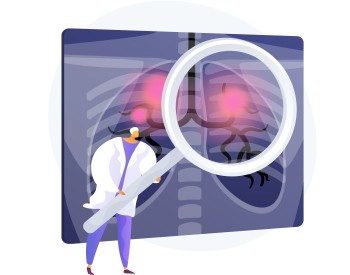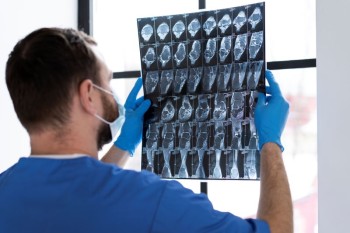
While often associated with larger anatomical structures, CT scans play a valuable role in examining smaller areas like fingers.
CT Finger Scan in India with Cost
CT Scan Finger in Detail
Introduction
While often associated with larger anatomical structures, CT scans play a valuable role in examining smaller areas like fingers. In this article, we will explore the details of CT Scan for the finger, its purposes, and how it aids in diagnosing and managing conditions affecting this small yet crucial part of the body.
Purpose and Scope of CT Scan for Fingers
A CT Scan for the finger provides detailed images of the bones, joints, soft tissues, and blood vessels in this localized area. It is instrumental in diagnosing fractures, dislocations, infections, tumors, and other conditions affecting the fingers.
When is a CT Scan of the
Finger Recommended?
A CT Scan of the finger is recommended when more detailed imaging is necessary to assess the extent and nature of finger injuries or conditions. It is often employed when X-rays alone may not provide sufficient information, especially for complex fractures, joint abnormalities, or soft tissue injuries.
Preparation for CT Scan of the Finger
Preparation for a CT Scan of the finger is minimal. Patients may be advised to remove any metal objects or jewelry from the finger, and they should inform the healthcare provider about any existing health conditions or medications.
Procedure of CT Scan for Fingers
During the procedure, patients place the affected finger or hand on a specialized table, which then moves through the CT scanner. The scanner captures detailed images from various angles, providing a comprehensive view of the finger's internal structures.
Benefits and Risks
CT Scans for fingers offer high-resolution images, aiding in the accurate diagnosis of a range of conditions. While generally safe, the procedure involves exposure to ionizing radiation, and the benefits are carefully weighed against the potential risks, especially considering the small size of the area being scanned.
Interpreting CT Scan Finger Results
Expertise is crucial in interpreting the results of a CT Scan for the finger. Radiologists analyze the images to identify fractures, joint abnormalities, soft tissue injuries, or other conditions affecting the finger. The detailed information obtained guides treatment decisions.
Conditions Diagnosed
Through CT Scan Finger
CT Scans for fingers are effective in diagnosing various conditions, including fractures, dislocations, ligament injuries, infections, and tumors. The detailed images allow for precise identification and characterization of these issues.
Alternatives to CT Scan Finger
While CT Scans are powerful diagnostic tools, alternatives like X-rays or MRI may be considered based on the specific clinical scenario. Each method has its strengths and limitations, and the choice depends on the information needed for an accurate diagnosis.
Conclusion
In conclusion, a CT Scan for the finger is a valuable tool for diagnosing and managing various conditions affecting this small yet intricate part of the body. The detailed imaging it provides ensures accurate diagnosis, guiding healthcare professionals in providing effective treatment for finger-related issues.
Frequently Asked Questions About CT Scan Finger
1. What is the purpose of a CT Scan for the finger?
A CT Scan for the finger provides detailed images of the bones, joints, and soft tissues, aiding in the diagnosis of fractures, dislocations, infections, and other finger-related conditions.
2. How is a CT Scan for the finger different from other imaging methods?
CT Scans offer detailed cross-sectional images, providing a comprehensive view of the finger's internal structures. This is particularly beneficial for assessing complex fractures and joint abnormalities.
3. Is the procedure painful?
No, the procedure is generally painless. Patients may experience slight discomfort from staying still during the scan, but it is well-tolerated.
4. Are there any risks associated with a CT Scan for the finger?
While generally safe, exposure to ionizing radiation is a potential risk. However, the benefits of accurate diagnosis often outweigh the risks, especially for localized scans.
5. How long does the procedure take?
The duration of a CT Scan for the finger is relatively short, typically taking around 10 to 15 minutes.
6. Can children undergo a CT Scan for the finger?
Yes, children can undergo a CT Scan for the finger. However, healthcare providers consider factors such as the child's age, size, and the necessity of the scan when making this decision.
7. Is contrast dye used in a CT Scan for the finger?
In most cases, contrast dye is not necessary for a CT Scan for the finger. The procedure primarily focuses on capturing detailed images of the finger's internal structures without the need for contrast enhancement.
8. How soon can results be expected after a CT Scan for the finger?
Results from a CT Scan for the finger are typically available shortly after the procedure. Healthcare providers may discuss the findings with the patient immediately or during a follow-up appointment, depending on the situation.
9. Are there any specific limitations after a CT Scan for the finger?
Generally, there are no specific limitations after a CT Scan for the finger. Patients can resume their regular activities unless advised otherwise by the healthcare provider. It's essential to follow any post-scan instructions provided.
10. Can a CT Scan for the finger detect nerve injuries?
While CT Scans primarily focus on bones and joint structures, they may reveal indirect signs of nerve injuries, such as fractures near nerves. However, for a detailed assessment of nerve injuries, additional imaging methods like MRI may be recommended.
11. Are CT Scans for the finger covered by insurance?
The coverage of CT Scans for the finger by insurance varies. It depends on the specific insurance plan, the reason for the scan, and whether it is deemed medically necessary. Patients are advised to check with their insurance provider for details on coverage.
12. Is there a specific age limit for undergoing a CT Scan for the finger?
There is generally no specific age limit for a CT Scan for the finger. The decision to perform the scan is based on the individual's health needs, and factors like age are considered in consultation with healthcare providers.
13. Can a CT Scan for the finger detect arthritis?
CT Scans can identify signs of arthritis, such as joint space narrowing and bone changes. However, other imaging methods like MRI or specific arthritis-related tests may be more suitable for a comprehensive evaluation of arthritis in the finger.
14. What should I do if I have metal implants in my finger?
Patients with metal implants in the finger should inform their healthcare provider before the CT Scan. While metal can cause artifacts on the images, modern CT scanners are equipped to minimize such distortions, and healthcare providers can adjust the procedure accordingly.
15. How often can one undergo a CT Scan for the finger?
The frequency of CT Scans for the finger depends on the medical necessity. Healthcare providers assess the need for repeat scans based on the specific health condition and the information required for effective diagnosis and treatment planning.
(0)
Login to continue



